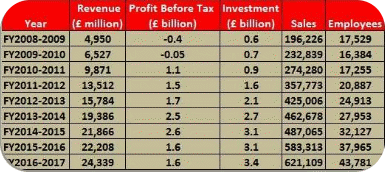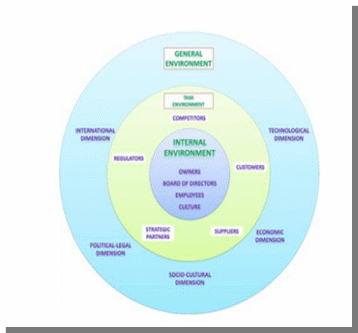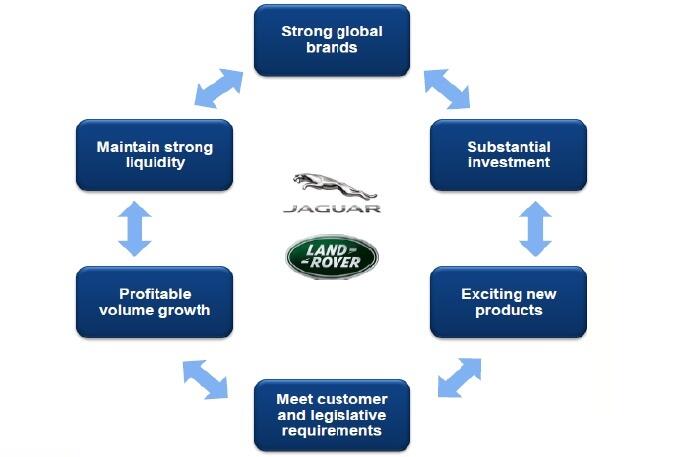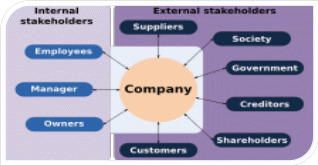Introduction
Tata Motors, which is one of the globally recognized automobile producers, was established in 1945. Its main offices are located in India. Tata is the world’s fourth-largest truck maker and second-biggest bus producer. Tata Motors has segments that are tailored to serve commercial, service, automobile, and commuter markets around the globe. In addition, the company has joint ventures with Cummins, Fiat, and Daimler Benz. In 2008, it acquired Land Rover and Jaguar brands. This decision is presented as a bad move due to the predicament it brought to the company. Regarding the company’s ownership structure, Tata Sons have approximately 27% stake while Tata Consultancy Services Limited and Tata Investment Corporation hold shares of about 73% and 68% respectively (Anand, 2016). The company operates in different geographical areas, including Europe and America.
The available evidence indicates the extent to which Tata’s decision to acquire Jaguar and Land Rover (JLR) weakened the organization’s position. Particularly, the decision was characterized by trouble, which was complicated by the onset of the global financial crisis. Stakeholders, including the chairperson of Tata Motors Group and Ford Motors, supported the decision. This paper’s conclusions indicate that the decision was counterproductive because it resulted in challenges of cash revenue flow due to the prevailing inflexible credit conditions. Firstly, this case study discusses the basis of the decision to acquire JLR followed by how specific factors or social actors in the company’s internal and external environment influenced the idea of obtaining JLR. Finally, it examines power structures and relations in organizational decision-making based on institutional and stakeholder theories applicable to the JLR acquisition decision.
Analysis of the Decision
The Decision-Making Process
According to Timmons and Bunkely (2008), the company was given a credit facility of about 3 billion USD to finance the acquisition of JLR. This money was scheduled for refunding in June 2009. However, by the end of 2008, Tata was only able to pay 1 billion USD. As the primary decision-makers and stakeholders in the acquisition deal, the company’s top management did not worry over the far-stretched credit facility since it corresponded with the organization’s strategic growth initiatives. Ford Motors’ administrative team also supported the move. Tata focused on consolidating its domestic and overseas markets through strategic collaboration and acquisitions (Nair, 2018). Tata Motors completed its acquisition deal of JLR from Ford Motors in June 2008. According to Nair (2018), some of the acquisition considerations entailed JLR’s production units, the certification of intellectual property rights, and different national sales entities located across the world. The purchase of JLR added more credit burdens. For instance, as Nair (2018) reveals, Tata also purchased Tetley and Corus on loan.
Acquiring JLR was a deliberate move. The company was convinced that the acquisition of JLR would strengthen its global position in the automobile industry. This expectation was founded on the fact that JLR not only had a global presence but also a brand with significant equity value. After signing the acquisition deal, Ratan Tata, the leader of Tata Motors Group, observed, “We are very pleased with the prospect of Jaguar and Land Rover being a significant part of our automotive business” (Singh & Shalender, 2014, p.147). This major stakeholder confirmed the Tata fraternity’s big respect for the JLR brand. Hence, he was willing to put all possible efforts to safeguard JLR’s British legacy while supporting its competitiveness in the market. JLR’s management team and employees would continue to offer their expertise and long-history experience as the key pillars of business growth and profitability.
Tata was optimistic about JLR’s future fortunes as a component of Tata Group amid Ford’s decision to sell the two brands. After years of operation as part of its PAG, Ford had not recorded the anticipated benefits. Hence, it is challenging to understand the capacity of Tata’s management team to make decisions that could benefit the company in the long term. In 1989, Ford acquired JLR from Leyland. In the 1990s, market demand for various high-end vehicles reduced considerably due to hard economic times. However, high sales were still recorded in some markets such as Japan and Germany. Overall, by 2007, JLR reported losses that resulted in mass layoffs and the closure of some manufacturing plants (Raianu, 2018). In 2007, Ford Motors reported a total loss of 12.8 billion USD (Raianu, 2018). This amount was the highest since the formation of the company in 1903. As part of its plan of disposing of less profitable business lines, Ford sold JLR to Tata Motors in 2008 at 2.3 billion USD (Timmons & Bunkley, 2008). However, in the acquisition agreement, Tata was not to inherit JLR’s debt liabilities. Tata’s management team may be blamed for its poor decision-making process that focused on the anticipated benefits while disregarding some likely challenges similar to those experienced by Ford.
After acquiring JLR, Tata would own a nano car priced at only 2,500 USD (Shafiulla, 2014). It would also sell luxury vehicles such as Land Rover and Jaguar to global markets. The company would supply products that fulfilled the needs of different markets. Consequently, it would have a global reach in all niches. The company would also possess high-end design facilities originally unattainable due to JLR’s protection of intellectual rights. Tata also wanted to access new technologies. Its local brand, Indica, and Safari had challenges, including vibrations and internal noise. Adopting JLR technologies would help to resolve these problems, hence creating more customer satisfaction in the Indian domestic market.
Corus was the primary supplier of various high-grade steel used in the automotive industry in Europe and the U.S. JLR relied on this entity to supply competitive steel materials. Since Corus was part of Tata, acquiring JLR implied that it would provide internal synergy for the entire Tata Group. As shown in Table 1, this collective synergy enabled JLR to make profits in 2017. Through the acquisition, Tata was sure of diversifying its products, which mainly depended on the local Indian market. This segment accounted for 90% of its total revenue flow. The decision made would also result in the diversification of JLR’s geographical reach to include South East Asia. Before the deal, the U.S. accounted for 30% while Europe had a share of 55% of the total JLR’s sales volume (Pathak, 2016). In 2018, JLR reported a loss of 270 million pounds, which originated from a market slip in China despite reporting strong performance capabilities in America and the UK (“Jaguar Land Rover posts £3.4bn loss as China demand slips,” 2019). The demand for cleaner models indicated JLR’s challenging moments because its models mainly used diesel. In Europe, sales for diesel-powered automobiles have been reducing.

The Influence of Social Actors on the Decision to Acquire JLR
Organizations make specific decisions in response to various specific factors that characterize their internal and external environments. Figure 1 illustrates the interrelationship between various actors in these settings for any company, including Tata.

Economic and technological dimensions played a huge role in shaping Tata’s decision to acquire JLR. These two elements form the external environment of an organization (Jablonski, 2017). Technology influences all business operations. It plays a critical role in enhancing research and new product development processes. Through JLR, Tata wanted to acquire the necessary technology to improve its domestic product lines, including Indica and Safari (Bryant, 2019). It also sought to develop the capability to benchmark and share knowledge repositories accessible from JLR. For Tata, technology-based investments were regarded as vital in ensuring its competitiveness in both local and international markets.
According to Jablonski (2017), economic factors denote all financial policies and conditions that influence business decision-making procedures. A stable economic atmosphere allows an organization to tap into the available credit lines to facilitate expansion plans necessary for higher economies of scale. Before obtaining JLR, Tata had already acquired some other brands on credit arrangements as a part of its growth strategy (Timmons & Bunkley, 2008). Therefore, it had evaluated and determined that its economic environment suited its approach to business. Tata was concerned about its ability to have a global appeal to deliver optimal returns to its shareholders. Nevertheless, the start of the international financial crisis introduced some challenging moments.
According to Bryant (2019), JLR’s acquisition worsened Tata’s earnings volatility due to economic challenges encountered in key Jaguar and Land Rover markets. In 2008, the effects of the global financial predicament were experienced in the U.S. and Europe (Barnett, 2015). Financial crisis reduces net household incomes. During recessions, minimal sales reduced revenue, and low stock prices characterize an economy (Barnett, 2015). Hence, an economy experiences declining growth, which usually leads to increased unemployment levels accompanied by mass layoffs. The deteriorating demand for products and services makes results in losses (Barnett, 2015).
Tata witnessed the above situation in its American and European markets. Apart from spending 2.3 billion USD to facilitate the acquisition process, the company had also planned to invest 1 billion USD in JLR (Timmons & Bunkley, 2008). As Shafiulla (2014) observes, this expenditure was huge because the organization had also used 400 million USD to develop its nano car and fulfill its commitment to the joint venture between it and Fiat. Therefore, with limited cash flows and the JLR acquisition deal, Tata was bound to witness profitability difficulties. In 2008, global automobile sales were 5% less when compared to what was recorded in 2009 (Chow, 2017). Consequently, most automakers resorted to cost-saving strategies, including dropping low profitable product lines and brand consolidation. Some considered withholding their planned research and development projects to retain funds.
Challenges in JLR’s main markets forced Tata to rely on Chinese and domestic bazaars. Although the former market remained stable, the domestic one was not profitable. Therefore, the prevailing financial challenges indicated Tata’s poorly timed acquisition decision. In the fiscal year ending 2009, the company’s domestic operations fell by 51% compared to the state of affairs in 2007 (Singh & Shalender, 2014). In a span of 10 months, it lost 517 million USD in its Indian domestic operations and an additional 510 million USD in the JLR acquisition endeavor (Singh & Shalender, 2014). However, more than a decade later, the organization has learned from its previous mistakes regarding its decision-making expertise. As illustrated in Figure 2, by 2020, Tata expects to have made significant progress, including making JLR a competitive international brand.

Power Structures and Relations in Organisational Decision-Making
Organizational power implies a company’s ability to control the likelihood of an unanticipated decision that influences its operations (Adler, du Gay, Morgan, & Reed, 2014). Tata is divided into a hierarchical structure that recognizes its chairperson as the head of the company. Therefore, the legitimate power to make any decision, including that of acquiring JLR, includes delegating authority to different hierarchical positions. The ability to enforce or influence decision-making depends on the power bestowed to each organizational level (Alapo, 2018). However, it is risky to promote one hierarchy of power while excluding other ranks.
Decision-making involves interactions among various stakeholders who include customers, employees, and the top management team (Alapo, 2018). Thus, the effectiveness of decisions made depends on a team’s capacity to manage the relationship existing among all involved parties. Hence, it is crucial to find out whether Tata’s business environment was well aligned with its goals and the timing of the decision to acquire JLR. The dominant power determines the level of organizational resources be allocated to achieve the set objectives through strategic partnerships, including acquisitions. Nevertheless, the case of Tata evidences the need for distributing power to lower hierarchies to increase the extent of environmental scanning before making decisions that may ruin a company’s global position and operations. Evaluating the prevailing market conditions is instrumental in predicting the nature and magnitude of risks or strengths associated with a particular decision.
Stakeholder and institutional theories can help to comprehend the case of Tata’s decision to acquire JLR and the aftermath of the deal. Figure 3 shows different stakeholders that Tata needed to consider in its decision-making process.

The stakeholder theory requires an organization to respond to the interests of its stakeholders (Harrison, Freeman, & Sa de Abreu, 2015). In response, shareholders are expected to reciprocate with positive behaviors and actions that range from purchasing more shares, products, and services purchases to remain committed to an organization during difficult times. A decision to increase a company’s economies of scale through acquisition responds to the above concerns stipulated in the stakeholder theory.
According to the institutional theory, organizations experience pressure that may lead to the violation of particular normative values and standards (Cardinale, 2018). Tata’s decision to acquire different companies, including JLR, suggests its unlimited effort to exert its legitimacy as a global manufacturer of automobiles for all markets. The idea demonstrated Tata’s need for conforming to the standards accepted by the global population. Such reception would guarantee the growth of its brand equities while boosting customers’ satisfaction levels in international bazaars (Chaney, Slimane, & Humphreys, 2016).
According to Schilke (2018), the pressure emphasized by the institutional theory arises from external stakeholders who force an organization to behave and make decisions that conform to their expectations. From the stakeholder theoretical perspective, these expectations include the increasing value and returns on investments to shareholders (Jones, Harrison, & Felps, 2018; Nason, Bacq, & Gras, 2018). Once a brand becomes popular and well known, a company will have exerted its legitimacy to its existing and potential customers. Consequently, it becomes less strenuous to convince clients to buy a particular product.
Conclusion
The decision to acquire JLR and other popular brands may be seen as an attempt to create Tata’s brand association with high-end and reliable SUVs and luxury vehicles. Therefore, due to the brand association of Jaguar and Land Rover, Tata expected customers to perceive other product lines, including Indica and Safari, as embracing the same quality standards Ultimately, Tata would be perceived as delivering higher returns on shareholders’ investments as presented in the stakeholder theory. Tata Motors’ idea of acquiring JLR was projected to provide the necessary synergy for its growth as a multinational brand. Its domestic brand, namely, Safari and Indica, produced an internal noise that required high-end technologies to resolve them. This technology was readily available through Tata’s access to the intellectual and property rights of JLR. Apart from owning the world’s cheapest car, Tata also wanted to own high-end SUVs and luxury vehicles. Hence, owning them would open Tata’s markets not only in East Asia but also in Europe and the U.S. These concerns were well aligned with institutional and stakeholder theories. However, the onset of the global financial crisis of 2008 and 2009 proved that the decision of acquiring JLR was poorly timed. Tata had to bear the consequences manifested in the form of losses in domestic, American and European markets.
References
Adler, P. S., du Gay, P., Morgan, G., & Reed, M. (2014). Oxford handbook of sociology, social theory, and organization studies: Contemporary currents. Oxford, England: Oxford University Press.
Alapo, R. (2018). Organisational power politics and leadership experiences on the view and use of power in organisations. Management Studies, 6(1), 30-36. Web.
Anand, G. (2016). In India, a clash at the top of the Tata empire gets ugly.The New York Times. Web.
Barnett, J. (Ed.). (2015). Global financial crisis: Causes consequences and impact on economic growth. Hauppauge, NY: Nova Science Publishers.
Bryant, C. (2019). The wheels have come off at Jaguar Land Rover for Tata Motors.Web.
Cardinale, I. (2018). Beyond constraining and enabling: Toward new micro-foundations for institutional theory. Academy of Management Review, 43(1), 132-155. Web.
Chaney, D., Slimane, K. B., & Humphreys, A. (2016). Mega-marketing expanded by neo-institutional theory. Journal of Strategic Marketing, 24(6), 470-483. Web.
Chow, C. (2017). Family legacy and board dynamics: Lessons from Tata. Governance Directions, 69(7), 439-442.
Harrison, J. S., Freeman, R. E., & Sa de Abreu, M. C. (2015). Stakeholder theory as an ethical approach to effective management: Applying the theory to multiple contexts. Review of Business Management, 17(55), 858-869. Web.
Jablonski, A. (Ed.). (2017). Business models: Strategies, impacts, and challenges. Hauppauge, NY: Nova Science Publishers.
Jaguar Land Rover posts £3.4bn loss as China demand slips. (2019). Web.
Jones, T. M., Harrison, J. S., & Felps, W. (2018). How applying institutional stakeholder theory can provide sustainable competitive advantage. Academy of Management Review, 43(3), 371-391. Web.
Nair, U. (2018). 10 years of Tata-JLR: A journey from 5 billion pounds to 25 billion pounds. Web.
Nason, R. S., Bacq, S., & Gras, D. (2018). A behavioural theory of social performance: Social identity and stakeholder expectations. Academy of Management Review, 43(2), 259-283. Web.
Pathak, A. A. (2016). Tata Motors’ successful cross-border acquisition of Jaguar Land Rover: Key take-a ways. Strategic Direction, 32(9), 15-18. Web.
Raianu, M. (2018). The incorporation of India: The Tata business firm between empire and nation, ca. 1860-1970. Enterprise & Society, 19(4), 816-825.
Schilke, O. (2018). A micro-institutional inquiry into resistance to environmental pressures. Academy of Management Journal, 61(4), 1431-1466. Web.
Shafiulla, B. (2014). Tata nano to Tata no-no. IUP Journal of Marketing Management, 13(1), 78-86.
Singh, N., & Shalender, K. (2014). Success of Tata nano through marketing flexibility: A SAP-LAP matrices and linkages approach. Global Journal of Flexible Systems Management, 15(2), 145-160.
Sund, K. J., Galavan, R. J., & Huff, A. S. (Eds.). (2016). Uncertainty and strategic decision-making. Bingley, England: Emerald Group Publishing Limited.
Timmons, H., & Bunkely, N. (2008). Ford reaches deal to sell Land Rover and Jaguar.The New York Times. Web.